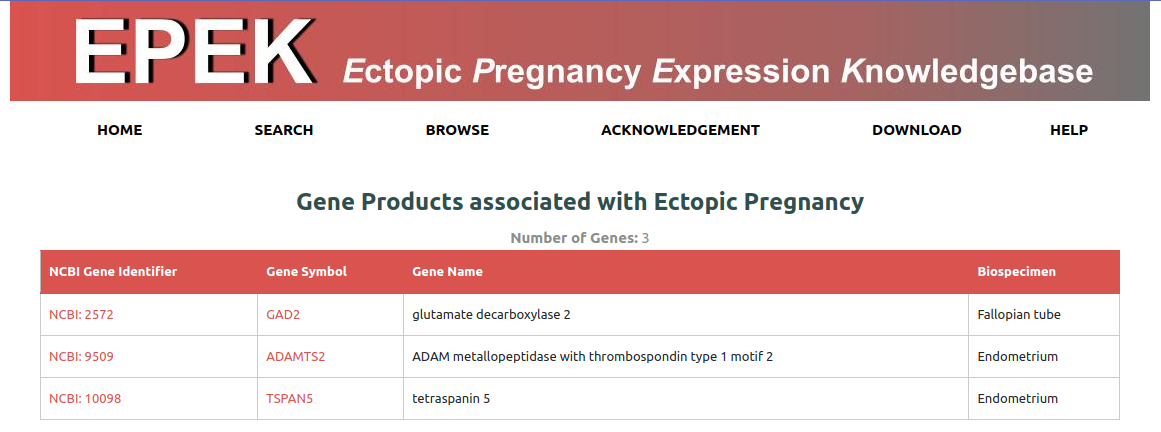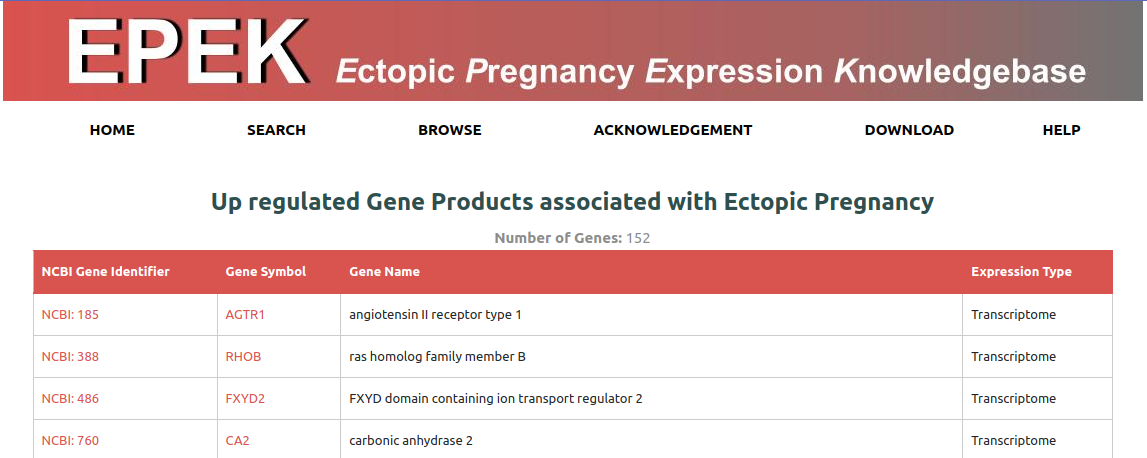| S. No. | Term | Definition |
|---|---|---|
| 1 | Ectopic pregnancy | A pregnancy complication where the fertilized embryo implants on a region other than the uterus |
| 2 | EIA | Enzyme immuno-assay |
| 3 | Follicular phase | Day 1-14 of the menstrual cycle |
| 4 | Hysterectomy | The surgical removal of the uterus |
| 5 | Implantation site | The area where the fertilised egg attaches |
| 6 | Intrauterine pregnancy | Pregnancies with normal uterine implantation |
| 7 | IVF | In vitro fertilization |
| 8 | LC-MS/MS | Liquid chromatography with tandem mass spectrometry |
| 9 | Luteal phase | Day 14-28 of the menstrual cycle |
| 10 | Mid-secretory phase | Day 14 of the menstrual cycle |
| 11 | Missed abortion | A condition where the fetus is not alive and the body does not expel the fetus or recognize that it is not viable |
| 12 | Pseudopregnant | The samples for this group were collected from women who were treated with human chorionic gonadotrophin (hCG) to imitate the state of pregnancy before they underwent hysterectomy for the removal of the fallopian tube |
| 13 | qPCR | Quantitative polymerase chain reaction |
| 14 | qRT PCR | Quantitative reverse transcription polymerase chain reaction |
| 15 | Spontaneous abortions | The natural loss of pregnancy before 20 weeks of gestation |
The SEARCH option in the navigation bar can be used to obtain records of specific biomarkers. Currently, the search options are limited to ONE entry per input box.
Gene Products by IdentifierUsing Gene Products by Identifier option, users can retrieve gene products in EPEK using the NCBI / ENTREZ ID, Official Symbol, or UniProt ID. The result to any query will return a table containing the NCBI Gene Identifier, Official Symbol, Gene Name and the associated Biospecimen. Users can click on the Official Symbol from the resulting table to view the information page containing UniProt Symbol, ENSEMBL ID, Protein Class, KEGG ID and Pathways, Ontologies, associated literature containing the supporting evidence for gene expression in Ectopic Pregnancy, technique used to ascertain differential expression, regulation, fold level change, P-value, control group, ectopic group, maternal factor, and expression type.


The Gene Products by Expression Level can be used to obtain list of gene products in EPEK by their expression level. Regulation dropdown will give options to choose from Up Regulated / Down Regulated / Both and Expression Type dropdown will give options to choose from Transcriptome / Proteome / miRNAome / All. The result to any query will return a table containing the NCBI Gene Identifier, Official Symbol, Gene Name and the associated Biospecimen. Users can click on the Official Symbol from the resulting table to view the information page containing UniProt Symbol, ENSEMBL ID, Protein Class, KEGG ID and Pathways, Ontologies, associated literature containing the supporting evidence for gene expression in Ectopic Pregnancy, technique used to ascertain differential expression, regulation, fold level change, P-value, control group, ectopic group, maternal factor, and expression type.


Using Metabolites option, users can retrieve metabolites in EPEK based on metabolite name or CAS ID. The result to any query will return a table containing the Metabolite Name, CAS Identifier, PubChem Identifier and the associated Biospecimen. Users can click on the Metabolite Name from the resulting table to view the information page containing SMILES, KEGG Identifier, ReconMap3, associated literature containing the supporting evidence for gene expression in Ectopic Pregnancy, technique used to ascertain differential expression, regulation, fold level change, P-value, control group, and ectopic group.


BROWSE is an interactive navigation tool providing quick links to data in EPEK. Each of the marked objects are clickable objects, directing to their respective pages on EPEK.

Clicking on Gene Products will direct you to the page containing tabulated list of gene products. The table contains the NCBI Gene Identifier, Official Symbol, Gene Name and the associated Biospecimen. Users can click on the Official Symbol from the resulting table to view the information page containing UniProt Symbol, ENSEMBL ID, Protein Class, KEGG ID and Pathways, Ontologies, associated literature containing the supporting evidence for gene expression in Ectopic Pregnancy, technique used to ascertain differential expression, regulation, fold level change, P-value, control group, ectopic group, maternal factor, and expression type.
Clicking on Transcriptome will direct you to the page containing tabulated list of transcriptome. The table contains the NCBI Gene Identifier, Official Symbol, Gene Name and the associated Biospecimen. Users can click on the Official Symbol from the resulting table to view the information page containing UniProt Symbol, ENSEMBL ID, Protein Class, KEGG ID and Pathways, Ontologies, associated literature containing the supporting evidence for gene expression in Ectopic Pregnancy, technique used to ascertain differential expression, regulation, fold level change, P-value, control group, ectopic group, maternal factor, and expression type.
Clicking on Proteome will direct you to the page containing tabulated list of gene proteome. The table contains the NCBI Gene Identifier, Official Symbol, Gene Name and the associated Biospecimen. Users can click on the Official Symbol from the resulting table to view the information page containing UniProt Symbol, ENSEMBL ID, Protein Class, KEGG ID and Pathways, Ontologies, associated literature containing the supporting evidence for gene expression in Ectopic Pregnancy, technique used to ascertain differential expression, regulation, fold level change, P-value, control group, ectopic group, maternal factor, and expression type.
Clicking on miRNAome will direct you to the page containing tabulated list of miRNAs. The table contains the NCBI Gene Identifier, Official Symbol, Gene Name and the associated Biospecimen. Users can click on the Official Symbol from the resulting table to view the information page containing UniProt Symbol, ENSEMBL ID, Protein Class, KEGG ID and Pathways, Ontologies, associated literature containing the supporting evidence for gene expression in Ectopic Pregnancy, technique used to ascertain differential expression, regulation, fold level change, P-value, control group, ectopic group, maternal factor, and expression type.
Clicking on KEGG Pathways will direct you to a tabulated list containing all the KEGG pathways and their corresponding gene products. The table contains Pathway ID, Pathway Name, No. of Genes, NCBI Gene Identifier, and Official Symbol. Clicking on NCBI Gene Identifier or Official Symbol will direct you to the corresponding information page.
Clicking on Ontologies will direct you to a tabulated list containing all the Gene Ontologies (GO) and their corresponding gene products. The table contains Accession, Ontology Term, Ontology Type, No. of Genes, NCBI Gene Identifier, and Official Symbol. Clicking on NCBI Gene Identifier or Official Symbol will direct you to the corresponding information page. Clicking on Accession will direct you to official GO information page.
Clicking on SNP will direct you to the page containing tabulated list of SNPs. The table contains the Official Symbol, Gene Name, dbSNP Identifier and NCBI Gene Identifier. Users can click on the Official Symbol view the information page containing dbSNP Identifier, ENSEMBL ID, associated literature containing the supporting evidence for SNP in Ectopic Pregnancy, technique used to ascertain differential expression, haplotype, risk, P-value, control group, and ectopic group.
Clicking on Metabolites will direct you to the page containing tabulated list of metabolites. The table contains the Metabolite Name, CAS Identifier, PubChem Identifier and the associated Biospecimen. Users can click on the Metabolite Name to view the information page containing SMILES, KEGG Identifier, ReconMap3, associated literature containing the supporting evidence for gene expression in Ectopic Pregnancy, technique used to ascertain differential expression, regulation, fold level change, P-value, control group, and ectopic group.
EPEK is a comprehensive knowledgebase of expression data relevant to ectopic pregnancy in humans that has been collated and curated from the published scientific literature. We are not liable for any inaccuracies or omissions of any expression data or published scientific literature pertaining to ectopic pregnancy, and users are recommended to use their own discretion while utilizing our resource. The primary goal of developing this resource is to facilitate basic research on ectopic pregnancy in humans, and it does not necessarily reflect the views or objectives of our employers or funders.